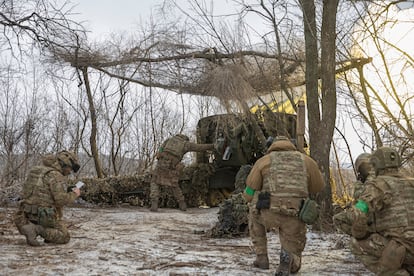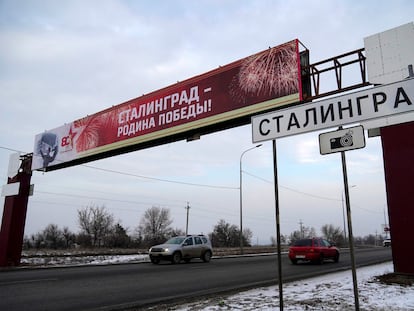Moscow planning offensive on three fronts to secure Donbas and Crimea military corridor
Ukrainian and Western intelligence services expect a new Russian assault in February but have ruled out another attempt to take Kyiv by attacking from Belarus

Almost a year after Moscow launched its invasion of Ukraine, the Russian military is planning another major offensive. Ukrainian Defense Minister Oleksii Reznikov confirmed during a press conference Sunday what Western intelligence agencies and front-line commanders have been warning of for days: Russian forces are gathering strength for an assault on three fronts, through Donetsk, Luhansk and on the southern flank in Zaporizhzhia. The Kremlin’s objective, according to the Ukrainian government and independent Russian media, is to take control of the entire Donbas region this spring.
Reznikov said Ukraine expects Russia to launch its campaign in February, with the additional goal of extending its foothold in the Zaporizhzhia region to secure its military corridor connecting the Russian border with the Sea of Azov and Crimea. EL PAÍS visited the Zaporizhzhia front last week, where several combat battalions voiced their suspicions that the calm of the past two weeks on the other side of the lines indicates that Moscow is amassing troops and ammunition for an attack.
Officers of the 102nd Territorial Defense Forces brigade said that the Russian objective is not to advance on the eponymous provincial capital of Zaporizhzhia, but to threaten Ukrainian positions in Donetsk from the south. The Institute for the Study of War (ISW) last week reported indications of Russian tank movement towards the front, but designed to attack from Vuhledar in Donetsk. Moscow is currently throwing forces on the city of Bakhmut, where slow but steady gains are being made. The ISW concurs that the main Russian assault will come in Luhansk, where last autumn a Ukrainian counter-offensive regained territory and pushed Russian forces back in Kharkiv.
In November, Moscow redoubled its efforts to take Bakhmut and three months later the Ukrainian defense remains resolute. According to the government of Volodymyr Zelenskiy, Russia’s chances of taking control of the entire Donbas region this spring are zero.
Both armies have been in a race against the clock to prepare an offensive by the end of winter or the beginning of spring. In a recent interview with EL PAÍS, Oleksiy Melnik, co-director of the Razumkov Centre in Kyiv, explained that time is of the essence because whichever side launches an attack first will force the other to change their plans. In this regard, Moscow has edged ahead of Kyiv. In a report issued on January 29, the ISW noted that delays in the provision of new weaponry for the Armed Forces of Ukraine from Kyiv’s Western allies has closed the window of opportunity for Ukraine to strike first.
Additionally, the ISW said that lengthy negotiations to provide new air defense systems, such as the US Patriot and the Franco-Italian Mamba, heavy tanks and long-range missiles have been a particular setback. Washington last week approved the supply of GLSDB maximum-precision missiles, which have a range of 150 kilometers (93 miles). These will be essential for Ukrainian forces to disrupt the supply chain of weaponry, fuel and supplies in the Russian rear, and to destroy enemy command posts.
Reznikov said that Russia had adapted its logistical and tactical network behind the lines to be beyond the range of Himars, US-supplied rocket systems with a range of 80 kilometers (50 miles). These artillery pieces proved key to last autumn’s Ukrainian counter-offensive, which liberated the western regions of Kherson province. The defense minister confirmed that Kyiv will not be able to field all the new Western weaponry agreed in recent weeks by February, making special mention of the Leopard tanks that are to be provided by a coalition of 12 countries. Reznikov also underlined that it is necessary to train mechanized units to operate the Leopards. US defense sources told Bloomberg recently that it may be nine months before the GLSDBs are operational in Ukraine.
NATO-supplied heavy armor is essential to a Ukrainian counter-offensive. Unlike the military successes in Kharkiv and Kherson last year, Russian forces have fortified their defensive positions to make it impossible for small-scale, rapid attacks using sections of around 12 troops with light armor support to break through. Ukrainian soldiers interviewed by EL PAÍS on the Luhansk, Bakhmut and Zaporizhzhia fronts in January reported a serious lack of ammunition for their main armaments, most of which are old Soviet models. Reznikov, however, said that the Ukrainian army is amassing materiel to withstand a Russian attack.
Putin’s desire for an offensive
Several sources close to the Russian High Command told independent media outlets Vazhnye Istorii and Novaya Gazeta Europa that a fresh offensive is the express wish of Vladimir Putin. “The generals are prepared to turn tens of thousands of fighters into mincemeat to please the whim of the high command,” a source told Novaya Gazeta Europa.
According to the same Russian military source, Putin’s forces face two serious problems. The first is that the Ukrainians “receive precise data on all our movements from Western intelligence services,” which allows the defenders to target troop concentrations with long-range weapons. The second is to hold on to territory gained at the cost of heavy losses due to strained logistical lines and sabotage: “Instead of settlements, we get a moonscape with the remains of a population that hates us,” the source added.
However, Ukrainian and US intelligence have ruled out the chance of a Russian attack on Kyiv through Belarus or Ukraine’s northern provinces because they have not detected troop movements on a scale to make such an undertaking possible. Based on leaks from the Russian military, there is little optimism among the ranks. “Plans to reach Kyiv have been drawn up again, but only because the country’s leadership demands it. No one believes it can be achieved; it will be suicide,” a source close to the Defense Ministry told Vazhnye Istorii. According to the same source, the military is in a state of “panic” because it believes that the Kremlin is overstating its capacity and paying scant regard to its shortage of high-quality armaments. Among the military, it is widely believed that rumors of an offensive on Kyiv are a ruse to divert Ukrainian forces from the front lines.
Mobilization in Russia
The Russian offensive could coincide with the speech Putin refused to give before the Russian parliament last year, despite it being a constitutional mandate. In Moscow, few expect the campaign to be launched on any symbolic date. According to state news agencies, Putin’s address to the Federal Assembly could take place on February 20 or 21, and he is not expected to deliver a message to the nation to mark one year of the war on February 24. In Kyiv, however, officials take it for granted that Moscow is planning something on the anniversary of the invasion.
Military analysts consulted by EL PAÍS in recent weeks agree that the cornerstone of Russian military power in Ukraine is that it has more artillery and ammunition, and a vast number of troops to be sent to the front in almost suicidal waves. Officially, the Russian Defense Ministry called up 300,000 people last autumn after Putin declared a partial mobilization, with the Russian president stating 18,000 more had volunteered. However, presidency sources told several Russian media outlets that the mobilization decree contains a secret clause allowing for the conscription of up to one million fresh recruits, although the Kremlin has denied this.
Should the Kremlin require even more troops after a new offensive has been launched, it would face a serious problem. Former military general and State Duma deputy Andrey Gurulyov said last weekend that he does not see a second mobilization as feasible “for at least half a year,” due to the limitations of the Russian war industry in supplying equipment and weapons. For his part, the chairman of the Defense and Security Committee of the upper house of the Duma, Viktor Bondarev, also ruled out a second mobilization “in the short term.”
According to political scientist Tatiana Stanovaya: “the intrigue about the Russian offensive is a secondary, even tricky question now. The main question is whether the war should be long or short.” As Stanovaya noted on Telegram, the Kremlin is aware that increased Western aid to Kyiv makes defeat a very real possibility, so Putin’s goal now, beyond territory, “is to do everything in his power to prevent the West from realizing this scenario.” As such, he will try to “break from the logic of a quick war” when considering his future moves.
Sign up for our weekly newsletter to get more English-language news coverage from EL PAÍS USA Edition
Tu suscripción se está usando en otro dispositivo
¿Quieres añadir otro usuario a tu suscripción?
Si continúas leyendo en este dispositivo, no se podrá leer en el otro.
FlechaTu suscripción se está usando en otro dispositivo y solo puedes acceder a EL PAÍS desde un dispositivo a la vez.
Si quieres compartir tu cuenta, cambia tu suscripción a la modalidad Premium, así podrás añadir otro usuario. Cada uno accederá con su propia cuenta de email, lo que os permitirá personalizar vuestra experiencia en EL PAÍS.
¿Tienes una suscripción de empresa? Accede aquí para contratar más cuentas.
En el caso de no saber quién está usando tu cuenta, te recomendamos cambiar tu contraseña aquí.
Si decides continuar compartiendo tu cuenta, este mensaje se mostrará en tu dispositivo y en el de la otra persona que está usando tu cuenta de forma indefinida, afectando a tu experiencia de lectura. Puedes consultar aquí los términos y condiciones de la suscripción digital.
More information
Archived In
Últimas noticias
Sydney Sweeney, the actress praised by Trump: ‘Women are up against what society wants them to be’
The Bolsonaro surname: An advantage or liability in Brazil’s 2026 presidential elections?
Raúl Rocha, from jet-setting with Miss Universe to arms trafficking and fuel theft
80,000 barrels of Mexican oil sent to Cuba: Havana drawn into the US–Mexico clash
Most viewed
- Reinhard Genzel, Nobel laureate in physics: ‘One-minute videos will never give you the truth’
- Pablo Escobar’s hippos: A serious environmental problem, 40 years on
- Charles Dubouloz, mountaineering star, retires at 36 with a farewell tour inspired by Walter Bonatti
- Why we lost the habit of sleeping in two segments and how that changed our sense of time
- The fall of a prolific science journal exposes the billion-dollar profits of scientific publishing










































